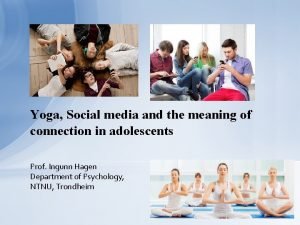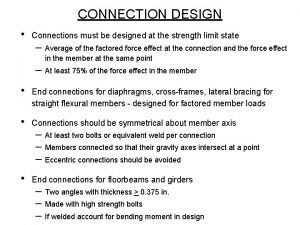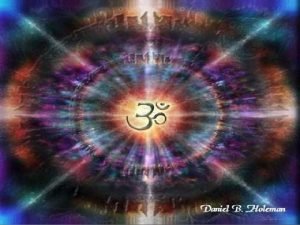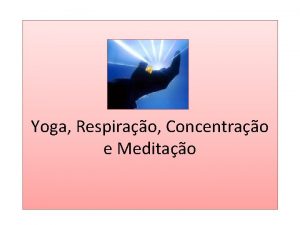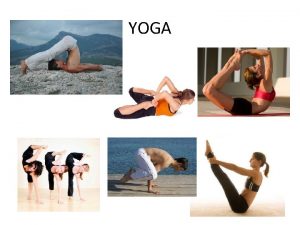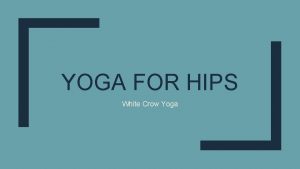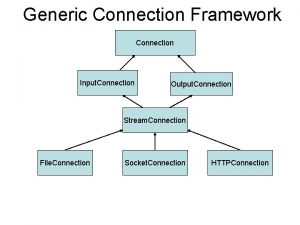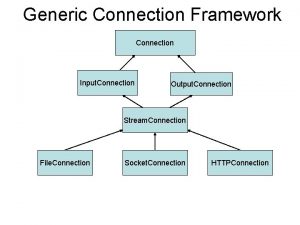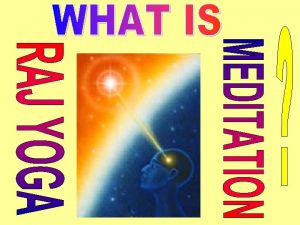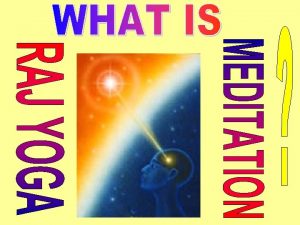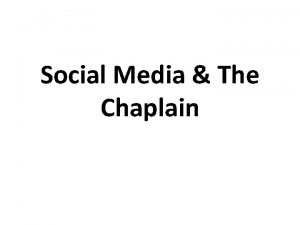Yoga Social media and the meaning of connection




















- Slides: 20

Yoga, Social media and the meaning of connection in adolescents Prof. Ingunn Hagen Department of Psychology, NTNU, Trondheim

Research projects on young people, social media and yoga • Yoga to promote young people's mental health and wellbeing? A study of the possible consequences of yoga for Norwegian teenagers, Spring 2015 (with Prof. Usha S. Nayar & Haakon Haakstad) • Yoga and Mindfulness as stress reducing methods through technology and active participation in school , 2015 -2016 (with Elin-Kristin Hem) • Young Adult’s use and mastery of digital communication media: The role of “new” media technology in the lives of students, 2015 - 2016, following up a study from 2005/2006 (with Professor Ron E. Rice & Esi Hewton)

The always on(line) generation • Since the early 2000, young people have been • described as «digital natives» and the «net generation» . • The mobile phone (smartphone especially) and PC are integrated into young people’s lives • More and more young people own a smartphone, and research suggests over 60 % check their smart phone every 15 minutes or less (Rosen et al, 2012) • «Thirty years ago we asked what we could use the computer for. Now the question is what we don’t use them for» (Turkle 2011: 590). This question is even more relevant for the smartphone.

Social connectivity: In the era of the smartphone (Pierce, 2010), people walk around with their own «mini portable computer» One of the most important functions of mobile phones and computers is social connectivity; to facilitate social relations with friends and family Young people use their smartphones to be in contact with their peer almost 24/7, especially through social media Digital media are great resources in (young) people’s lives, but their negative effects are also becoming more noticable.

FOMO – Fear of Missing Out • While being able to be connected is great, there also negative aspects like the pressure to be constantly available, and the fear of missing out (anxiousness) • Problematic issues also include digital dependency and addiction; and a number of media companies aim to make users, including young people «hooked» (Weisberg, 2016) • However, digital awareness is also increasing, and there is a trend for more JOMO – «Joy of Missing Out» , at least more consciousness about use, potential dangers and misuse

Yoga & connecting with Self: • Young people today experiences lots of external demands in their daily lives; • expectations from peers to be available all the time through social media • commercial pressures to be thin, cool, perfect, and have the right brands and latest gadgets • demands from school and parents to perform and succeed • Yoga can be a tool for young people to connecting with oneself; to be able to experience what is going in their own body and mind. • This may hold great potentials psychologically.

Yoga and self-efficacy: • Practicing yoga seems to improve people sense of self-efficacy • Self-efficacy: One’s belief in ones ability to succeed in specific situations or to accomplish tasks • This belief can be very important for how one approaches tasks, goals and challenges in life • A person’s core belief in themselves - that their actions can make a difference in their own lives, in their environments and in society are at the root of their actions. • Albert Bandura (in his socio-cognitive theory of motivation and learning, 2010 &1977) emphasized that unless people believe in themselves and their ability to produce the desired effects by their actions, they have little incentive to undertake activities.

Yoga and self-regulation • Self-regulation is a very important concept from a psychological perspective, as it relates to people’s wellbeing and selfdevelopment • Self-regulation is something individuals engage in on a daily basis to various degrees Examples: • giving in to cravings for food (when not really hungry) or not • to be able to sleep and get up according to daily demands • to walk away from situations when one is angry rather than having an emotional outburst • to cope with everyday stress in constructive manners

The concept of self-regulation • Self-regulation can be understood an individual’s ability to override or control their emotions, impulses, thoughts and automatic and habitual behavior, so their responses are adaptive for situations (Gailliot, Mead and Baumeister, 2008) • Self-regulation makes it possible for us to choose flexible and wise strategies which are appropriate for the context, and also to follow socially defined norms and rules (cf. Bauer and Baumeister, 2011; Cook-Cottone, 2015) • Self-regulation includes both up- and down-regulation of emotions, responses, and behaviour som they are appropriate for different contexts and short- and long-term goals

The impact of self-regulation • To develop good self-regulation skills has an impact of virtually all aspects of a person’s life (Gailliot et. al, 2008) • Good self-regulation skills will often result in better relationships, improved health and also greater achievements (Gendolla et. al, 2015) • Self-insight is an important part of self-regulation, and so is attention • Emotion regulation and sleep-regulation are central elements of good health and for coping with stress • Poor self-regulation skilles can result in poor health, substance abuse and also use of violence

Self-regulation and stress: • Popular definition of stress is that people experience stress when faced with demands or situations which exceed their ability to cope or manage (Lazarus and Folkman, 1984) • We face stress when challenges or obstacles keep us from reaching our desired goal, or directs us towards an undesired event • Individuals need to use self-regulatory strategies to cope with stress • Self-regulation and stress are not only psychological concepts, • but also play an important role on the biological and • neurological levels

Yoga, self-efficacy, self-regulation, coping with stress In our study of teenagers and young adult yoga participants the results suggested that yoga can be a valuable tool to promote self-regulation and self-efficacy, as well as reduce stress • In our study of yoga in school we saw that even small doses of yoga and mindfulness would help young people to cope much better with stress in their everyday lives. • Technology could be a tool to teach yoga and mindfulness in school, but perhaps most fruitfully in combination with personal instruction

Connect with self: • Yoga can function as a way for practicioners to connect • with themselves; to increase their self-insight: • «I didn’t really know how much stress I really had, until I… did yoga, and took it away» (Lars, 15 year old male) • «Yoga is like… you can get back to yoga, to find out why you reacted the way you did, understand more, so that next time you can react more in line with what you really want» (Tore, 27 year old male) • «I have become more aware of, well how I feel, and… or how my body feels, and well, how I feel in differerent situations, or. . Well. . When I get here and I am supposed to feel my body, then I think a bit more about… a bit more about how I actually feel, or what I feel (…) I can feel how stressed I am, and may be do something about that feeling that I have (…) If I am very stressed, to feel how I am, and what I can do to release that stress and … become relaxed. (…) You focus only on your own body and how you feel, so. . Don’t think about other things and… just see how you feel right then and there» (Linn, 18 year old female)

Yoga to handle difficult situations, relax and cope with stress For example, one candidate told us: «When I was going to an MR-examination, I felt I could use it. Because then I started to think about yoga, and the exercises where we lay still, rather than to think that I was lying in a very small room. I use it to think of something else than me being afraid, so I used to think that I could relax and… not be afraid of something that wasn’t really something to be afraid of» (Lars, 15 years, male) This person also found yoga practice useful for sleep regulation: «I think about it before I go to bed. If I’m not tired then I try the… things at the end where you are supposed to feel the upper part of your body, feel your fingertips, then I do that untill I feel like I just can’t be bothered anymore and just… lay down to sleep» • «When we lay down and relax its’s just really nice to lie there (…) I almost fall asleep, and just relax (…) It can be nice to carry with you. The fact that you can do it if you need it. » (Anna, 12 year old female) • «I noticed when I had a lot of exams and a lot of stress I came back to all of this to find time for yoga because it helps, both because you move and you get to not think of anything else. You find a way to take the time to just be present, away from all the stressful things. » (Sanna , 25 year old female)

Yoga to deal with negative emotions • Both for short-term and long-term yoga practitioners, regulation of emotions seems to have increased: • «I think maybe I feel a bit calmer. That I don’t feel that much need to be angry, or, I can be a bit more relaxed» (Anna, 12 years old female) • 18 year old Linn described: «I have just gotten better at using yoga as a tool, you know, to kind of… well… to handle the emotions I have. » • «A long-term yoga practioner described: I used to be angry a lot before… or, shouting and screaming, you know, that kind of angry. I wasn’t angry for a long time, just… these outbursts. And I’m not really like that anymore, because I manage to, sort of think, pull myself back and… take a break… and think a little. And… and usually it’s okay, you don’t need to explode, you can talk about it in stead» (Nina, 25 year old female).

Yogic breathing: • Increased awareness of breathing served several functions for our interviewees, like a release of tension and providing calmness • • • «I feel that it might be of value to breathe a little, a little deeper. It’s like that in a hectic day that you… that you hold your breath a little. Because you are stressed. Because you just don’t prioritize breathing. » (Vanja, 24 year old female) «Sometimes when I ‘m tired, and a bit stressed, and may have ran a little and my pulse is high, I try to take a little more control of my breathing and calm down a little more. » (Anna, 12 year old female) «In yoga there’s this focus on breathing basically all the time. From start to end almost. So… in a way to coordinate the movements you do with breathing (…) to me at least it becomes much more like an anchor that you sort of try to return to, away… away from all those thoughts that come up (…) I can control my breathing (…) almost hijack the stress reactions» (Sanna, 25 year old female)

Yoga as a sanctuary: • The informants for our study describe yoga, both in the studio and when practicing alone, as a «sanctuary» : • «It has a kind of relaxing feeling once you step in [to the yoga studio]. May be you feel a bit safer (…) I mean, the colors of a room can often change a little. And you just feel, safe, that you are a bit more… yeah, that you feel really safe» (Anna, 12 year old female). • One informant expressed that yoga gave him some time to himself so he could also manage tasks and his other tedious chores with more ease: • «I think that it makes me much calmer than if I haven’t done it. Then I have a way out if there are things I do not like to do. » (Lars, 15 year old male) • For Linn (25 year old female) yogic practice: • «It’s a place where I can breathe, where I just… forget everything else. Where I can just be myself. »

Conclusory remarks: • Our studies suggest that practicing yoga increases the contact with one’s own body, mind, feelings/emotions, and reaction patterns • Thus, practicing yoga increases the ability to connect with self, selfefficacy, the ability to self-regulate and to cope with stress • Yoga can be part of a healthy reaction to the media saturated and rather stressful lives many people experience in todays world. • Young people experience external pressure and stress to the extent that it impacts their mental health and life quality. • Yoga and mindfulness could be tools for young people to be agents in their own lives; to improve their mental health, happiness and the meaningfulness of their lives

Thanks We would like to thank the teenagers and young adults who have participated in our studies! We are also grateful to the students (Stine B. Kofoed, Haakon T. Haakstad, Solveig E. Tvedt, Carl-Erik Høyum, Karoline Krogh. Larsen, and Jeanette Vik) who played an active part in the study we draw our examples from , and also Elin-Kristin Hem and Esi Hewton Professor Ingunn Hagen (in cooperation with Professor Usha S. Nayar)

References: • Bandura, Albert. Self-efficacy: Toward a unifying theory of behavioral change. Psychological Review, Vol 84(2), Mar 1977, 191215. http: //dx. doi. org/10. 1037/0033 -295 X. 84. 2. 191 • Bandura, A. (2010). Self-efficacy. In The Corsini Encyclopedia of Psychology (4 th Ed. pp. 1534 -1536). Hoboken, New Jersey: John Wiley & Sons. • Bauer, I. M. & Baumaster R. F. (2011): «Self-Regulatory Strength» . In: Vohs K. D. & Baumeister R. F. (Eds): Handbook of Self. Regulation, Research, Theory and Applications (2 nd edition). New York/London: Guilford Press. p. 64 -82. • Cook-Cottone, Cathrine P. (2015): Mindfulness and Yoga for Self-Regulation. A Primer for Mental Health Professionals. New York: Springer Publishing Company. • Gailliot, M. T. , Mead, N. L. , Baumester, R. F. (2008): «Self-Regulation» . In John, O. P. , Robins, R. W. , Pervin, L. A. (Eds. ): Handbook of Personality, Theory and Research (3 rd edition). New York: The Guilford Press. P. 472 -491 • Gendolla, H. E. , Tops, M. & Koole, S. L. (2015) : «Introduction: Grounding Self-Regulation in the Brain and Body. » In: Gendolla, H. E. , Tops, M. & Koole, S. L. (Eds. ): Handbook of Biohavioral Approaches to Self-Regulation. New York: Springer (p. 1 -6). • Lazarus, R. S. & Folkman, S. (1984): Stress, Appraisal and Coping. New York: Springer. • • • Pierce, A. (2010). The convergence of communication technologies. Tech Directions, 70(5), 12 -13. • Turkle, S. (2011). Alone together. Why we expect more from technologi and less from each other. New York, NY: Basic Books. Rosen, L. D. , Cheever, N. A. , & Carrier, L. M. (2012). IDisorder: Understanding our obsession with technology and overcoming its hold on us. New York, NY: Palgrave-Mac. Millan.
 Yoga social media
Yoga social media Surface vs deep connections
Surface vs deep connections Slip critical connection vs bearing connection
Slip critical connection vs bearing connection Slip critical connection
Slip critical connection Slip critical bolted connection
Slip critical bolted connection Yogah karmasu kaushalam meaning
Yogah karmasu kaushalam meaning Kata yuj berasal dari bahasa
Kata yuj berasal dari bahasa Types of people media
Types of people media Making connections
Making connections Social thinking and social influence in psychology
Social thinking and social influence in psychology Social thinking social influence social relations
Social thinking social influence social relations Social media introduction
Social media introduction You must finish your homework before you go to bed
You must finish your homework before you go to bed Harmony fit
Harmony fit Hát kết hợp bộ gõ cơ thể
Hát kết hợp bộ gõ cơ thể Ng-html
Ng-html Bổ thể
Bổ thể Tỉ lệ cơ thể trẻ em
Tỉ lệ cơ thể trẻ em Chó sói
Chó sói Tư thế worm breton là gì
Tư thế worm breton là gì Bài hát chúa yêu trần thế alleluia
Bài hát chúa yêu trần thế alleluia
